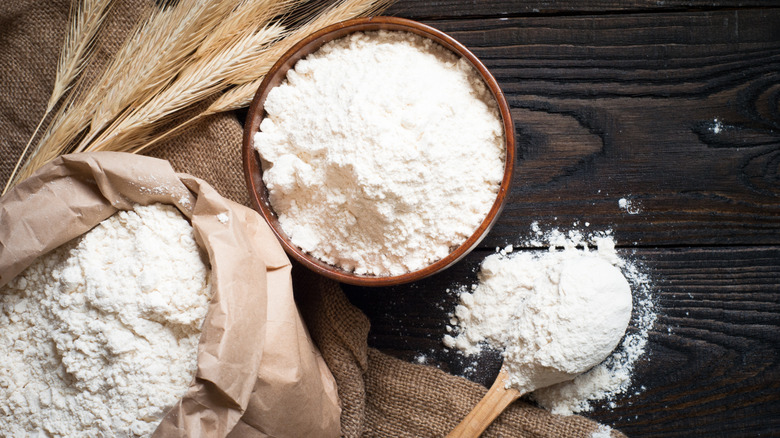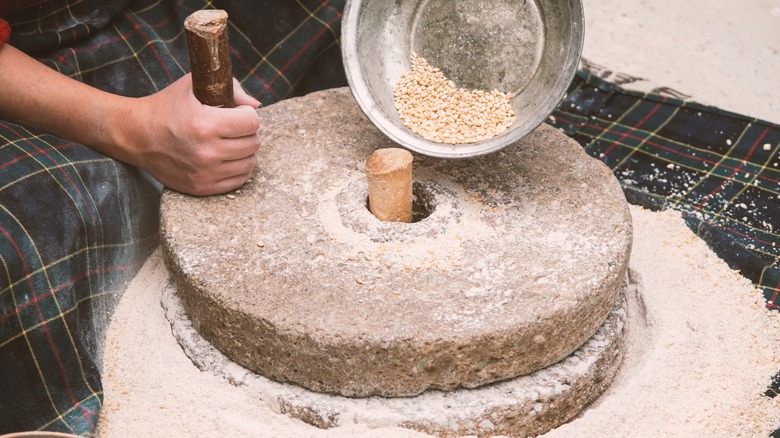Stone-Milled Vs. Roller-Milled Flour: What's The Difference?
It could be argued that mashing a couple of stones together is one of the greatest inventions in the history of humanity. The millstone may sound like a simple enough idea, but its invention and further development helped move human beings from exclusively hunter-gatherer societies to settled civilizations, per Flour.com.
Humanity began developing agricultural tools around 10 to 15 thousand years ago, and the millstone was one of the most important among them. When humans first cultivated easily stored crops like wheat, they tried chewing the hard grains as a food source but found them difficult to consume and digest. They then developed millstones to grind the grains into flour instead. Civilizations like ancient Egypt then used the flour to make early breads that not only saved their teeth from serious wear and tear, but were easier to digest as well.
According to Royal Lee Organics, this method of flour production was then replaced for the most part by rolling mills. Rolling mills were invented in the 19th century to create finer flour for pastries by crushing the grains between two steel cylinders. The resulting flour was then sifted to remove the outer bran for a longer shelf life, and reground into the common white flour we mostly know today.
Chatelaine reports that small mills are starting to bring back stone-milled methods, and the unique flour is becoming more widely available. It's important to know the key differences between these flours, and how to best use them both.
Stone-milled flours
There are a lot of benefits to tracking down stone-milled flours. Garden Accents says that stone mills work by pairing two large stones together that have had patterns called 'harps' carved into them. The grains are positioned between the stones, and the harps break them down and separate the interior germ and endosperm of the grain from the bran to make it more palatable.
The Scottish Mill points out that this process produces a rougher textured flour that also contains more of the nutrients from the whole grain. It also grinds the flour at a lower temperature than roller mills, which keeps many enzymes intact. Chatelaine reports that it also gives it a shorter shelf life because the oils that are present can go rancid when not properly stored. Stone-milled flours need to be kept in the refrigerator and are best used within one week, though Kitchn claims some can last up to six months.
Kitchn adds that stone-milled flour has a significantly stronger flavor. In fact, the strong, nutty flavor of fresh ground flour is hard for some diners that are expecting a more gentle taste. The presence of the bran also tends to create a denser loaf of bread as well. Bread's structure comes from its network of gluten. Once bran has been ground into flour, its sharp edges can cut through the gluten which prevents the same quality of structure from forming in the dough.
Roller-milled flours
The first roller-milled flours were introduced to the United States in the 1880s (via Serious Eats). According to Automatic Grain Mills, this innovation helped feed America as its population grew into the 20th century. This new method of making flour did come with some disadvantages though.
Royal Lee Organics reports that as early as the 1920s, the FDA was showing concern for the possibility of lost nutrition in the roller-mill process of creating white flour. Little Rae's Bakery adds that this lack of nutrition was a major problem as the popularity of white flour continued to grow. By the 1940s, the U.S. would mandate the enrichment of white flour with vitamins and minerals to return some nutrition to this staple food.
Kitchn claims that stone-milled flour is still considered more nutritious because it maintains the bran where many nutrients are stored. There are still flours that use the whole grain which are made with the roller-milled method, but SFGATE says that they contain less of the bran than stone-milled. If you're going for nutrition, then roller-milled flour will almost always fall short.
Roller-milled flour excels at producing a light, gentle texture though, and Kitchn recommends blending the flours to create a final baked good that will have the light body of conventional flour with the flavor and nutrition of stone-milled.
How to use both flours
Besides the differences in nutrition, flavor, and shelf-life, there are other qualities to consider in how these flours function when used in different recipes. Old Stone Mill says that its stone-milled flour is best suited for bread recipes. As Kitchn points out, recipes that consist mostly of flour allow the abundant and unique flavor of different stone-milled flours to come through. This way there aren't other elements or flavors to distract from the flour's naturally delicious qualities. Pizza doughs, flatbreads, and crackers are also great ways to make the most of stone-ground flour.
Kitchn adds that much of that flavor is thanks to the wheat's bran which is more often included in stone-milled flours. Removing too much of the bran by sifting the flour, or by grinding a finer flour may take away from that flavor. Taste of Home reports that the more finely you grind flour, the more of the bran is lost in the process. That means the benefits of stone-ground flour are often lost in recipes that call for cake or pastry flour. The advantage of this is that it will also produce a lighter, fluffier dough because the bran won't inhibit gluten development.
Possibly the best way to produce the highest quality baked goods then is to compromise between the two and use a blend of flours. As Kitchn points out, this allows for a well-risen dough without having to sacrifice much of the wheat's naturally delicious flavors.



